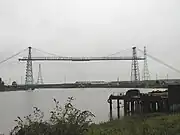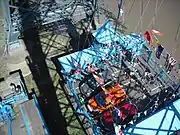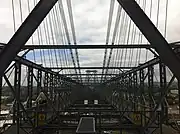Newport Transporter Bridge | |
|---|---|
 The bridge viewed from Coronation Park | |
| Coordinates | 51°34′14″N 2°59′08″W / 51.57064°N 2.98556°W |
| Carries | Motor vehicles, cyclists and pedestrians including buses and multi sized lorries. |
| Crosses | River Usk |
| Locale | Newport, Wales |
| Official name | Newport Transporter Bridge |
| Maintained by | Newport City Council |
| Heritage status | Grade I |
| Characteristics | |
| Design | Transporter bridge |
| Total length | 236m (774.28 ft) |
| Width | Three cars (gondola) (total width 108 ft / 33 m) |
| Longest span | 196.56m (644.88 ft) |
| History | |
| Designer | Ferdinand Arnodin |
| Opened | 12 September 1906 |
| Statistics | |
| Toll | Adult Single – £1.50 Adult Return – £2.00 Child Single – 50p Child Return – £1.00 Day Ticket (inc. unlimited trips on the gondola and walking across the top of the bridge) – £4.00[1] |
| Location | |
The Newport Transporter Bridge (Welsh: Pont Gludo Casnewydd) is a transporter bridge that crosses the River Usk in Newport, South East Wales. The bridge is the lowest crossing on the River Usk. It is a Grade I listed structure.
It is one of fewer than 10 transporter bridges that remain in use worldwide; only a few dozen were ever built. It is one of only two operational transporter bridges in Britain, the other being the Tees Transporter Bridge.
History
The bridge was designed by French engineer Ferdinand Arnodin. It was built in 1906 and opened by Godfrey Charles Morgan, 1st Viscount Tredegar, on 12 September 1906.[2] Newport Museum holds a silver cigar cutter which was presented to Viscount Tredegar on the day of the opening, as a memento of the occasion.[3]
Design
The design was chosen because the river banks are very low at the desired crossing point (a few miles south of the city centre) where an ordinary bridge would need a very long approach ramp to attain sufficient height to allow ships to pass under, and a ferry could not be used during low tide at the site.[4] The river is too narrow for a swing bridge or a bascule bridge (drawbridge).[5]
Principal dimensions
A Corporation of Newport drawing dated December 1902 is calibrated in metres. The height of the towers is 73.6 metres (241.5 ft), and the height to the underside of the main girder truss above the road level is 49.97 m (163.9 ft). The span between the centres of the towers is 196.56 m (644.9 ft), and the clearance between the towers is quoted as being 180.44 m (592 ft); however, including the cantilevered sections, the main girder truss gives the bridge an overall length of 236 m (774.3 ft). The distance between the centres of the anchorage caissons is 471.06 m (1,545.5 ft). Power to propel the transporter platform or gondola is provided by two 35 hp (26.1 kW) electric motors, which in turn drive a large winch, situated in an elevated winding house at the eastern end of the bridge. This winch is sufficient to drive the gondola through its 196.56 m (644.9 ft) total travel at a speed of 3 metres per second (9.8 ft/s).[5]
When compared with Middlesbrough's Transporter Bridge, the Newport Transporter is 5 m (16 ft) taller, but 23 m (75 ft) less in overall length. It also utilizes approximately 1,400 long tons (1,600 short tons) of steel compared to 2,600 long tons (2,900 short tons) used to construct Middlesbrough's Transporter (not accounting for steel used in foundations or concrete anchors).[5][6] This difference in weight is mainly due to the Newport bridge making use of cables to support and induce tension into its structure to a far greater extent than the Middlesbrough bridge.
The bridge is a Grade I listed structure, its Cadw listing describing it as "the oldest and largest of the three historic transporter bridges which remain in Britain, and also the largest of eight such bridges which remain worldwide".[7]
Other information
Today, the bridge is considered an “iconic symbol” of the city of Newport, particularly as a mark of its industrial heritage.[8] As well as a working transport link, the bridge is also open as a tourist attraction – visitors can climb the towers and walk across the upper deck for a small charge. The bridge forms part of the classified highway network and is also where route 4 of the National Cycle Network crosses the River Usk and route 47 begins. It was the focal point of the local millennium celebrations of 2000, where fireworks were fired from its length, and has been featured in several movies and television shows. It was the centre-piece of the Crow Point Festival in September 2006 to celebrate its centenary. It is used for charity events such as sponsored abseils.
Refurbishment
The bridge was shut down in 1985 because of wear and tear. Following a £3 million refurbishment, it reopened in 1995. Service was suspended again in December 2008 with the bridge facing a £2 million repair bill.[9] £1.225 million was spent on refurbishment, financed by grants from the Welsh Government, Newport City Council and Cadw. It re-opened on 30 July 2010.[10] The bridge was closed on 16 February 2011, because of operational problems, but re-opened again on 4 June.[11]
Appearances in popular media
The transporter bridge provided the setting for some scenes in the 1959 British crime drama film Tiger Bay, which was set in Cardiff and therefore gave audiences the impression that the bridge was in Cardiff and not Newport. The bridge also appears in an early scene in the 1972 experimental film The Other Side of the Underneath by Jane Arden and features extensively in the 1996 video for the song "Talk to Me" by Newport band 60 Ft. Dolls.[12]
Visitor centre
The Visitor Centre is located on the west bank and features exhibits on the history of the bridge, its construction and other transporter bridges around the world. The centre has a painting of David Pearce, the former undefeated Welsh and British Heavyweight Boxing Champion 1983–1985. Pearce used to run up the steps of the Transporter Bridge during his training. The centre is generally open at weekends,[13] but it is currently closed until Summer 2024, while extensive restoration of the bridge structure is performed and a new visitor centre is constructed.[14]
Gallery
 The bridge from the West bank to the North
The bridge from the West bank to the North The gondola in transit
The gondola in transit Gondola approaching the pier
Gondola approaching the pier Looking down onto the gondola
Looking down onto the gondola Main girder, from inside
Main girder, from inside Walkway on top of the bridge showing the pulley cable
Walkway on top of the bridge showing the pulley cable.jpg.webp) Newport Transporter Bridge, 1931
Newport Transporter Bridge, 1931 The Transporter Bridge in 2008
The Transporter Bridge in 2008
See also
References
- ↑ "Visit".
- ↑ "City transporter bridge centenary". BBC News. Newport. 12 September 2006. Retrieved 17 August 2013.
- ↑ "Now and Then: The opening of the Newport Transporter Bridge". South Wales Argus. 28 April 2015. Retrieved 3 September 2023.
- ↑ Windsor, Henry Haven, ed. (1922). "Suspended Ferry Carries Traffic Across English River". Popular Mechanics Magazine. Vol. 37. p. 60–61. Retrieved 30 November 2023.
- 1 2 3 Taylor, Alun (1 October 2021). "Is it a bridge? Is it a ferry? No, it's the Newport Transporter". The Register. Retrieved 30 November 2023.
- ↑ Coleman, F. C. (16 December 1911). "Novel Transportation Bridge in Great Britain". Scientific American. Retrieved 30 November 2023.
- ↑ Cadw. "Newport Transporter Bridge (Grade I) (3076)". National Historic Assets of Wales. Retrieved 3 September 2023.
- ↑ "BBC - Wales History: Newport Transporter Bridge".
- ↑ "Nine historic buildings get £385k". Newport: BBC Wales News. 13 January 2009. Retrieved 17 August 2013.
- ↑ "Transporter Bridge to re-open". Newport: South Wales Argus. 25 July 2010. Retrieved 25 July 2010.
- ↑ "Newport Museums & Heritage Service : Homepage". Newport.gov.uk. Retrieved 18 September 2016.
- ↑ 60 Ft Dolls - Talk to Me (Version 1) on YouTube
- ↑ "Campaigners hope to put statue honouring 'Newport's Rocky' on Gilligan's Island".
- ↑ "Newport Museums & Heritage Service: Transporter Bridge".
External links
- Friends of Newport Transporter Bridge
- Photo Gallery
- Dimensioned blue-print drawing of Newport's Transporter Bridge
- On Google Maps
- Crow Point Festival – Transporter Bridge centenary celebrations
- Newport Transporter Bridge at Structurae
- A collection of photographs, documents and plans relating to the construction of the Newport Transporter Bridge, 1902–06
- Newport Council page for the transporter bridge
- Newport's Transporter Bridge page on http://www.newportpast.com/

